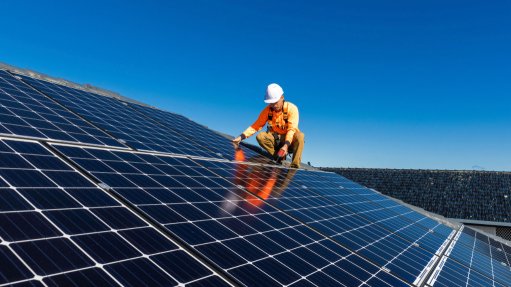The circular economy movement and its place in South Africa
The Department of Science and Innovation (DSI) hosted a circular economy colloquium in partnership with the European Union (EU) from November 19 to 20. The notion of a circular economy may seem like a fashionable new buzzword.
In some respects, it has taken on the feel of the newest flavour of the month, but it is a concept that has been around for many years. One can trace its roots back to the 1970s in countries that sought to find more effective and holistic ways to manage the relationship between resource extraction, production, disposal of waste and measures to deal with products after they have completed their shelf life. The underlying philosophy is to get more out with less at both the production and consumer ends of the life cycle of goods.
Some of the major schools of thought that have come to shape the notion of the circular economy are that of the performance economy of Walter Stahel; the cradle-to-cradle design philosophy of William McDonough and Michael Braungart; biomimicry, as articulated by Janine Benyus; the blue economy systems approach described by Gunter Pauli, who actually lives in South Africa; and a few others.
Circularity also has strong associations with industrial ecology – the idea that a material should be used in such a way that it can be circulated in an economy so that it is used at the highest value for the longest period possible. Countries like China have built the concept in some of their industrial development zones.
Another way of thinking about material inputs and the products that are made from them is in terms of three ‘Rs’: reduce, reuse and recycle. One may add a fourth R, namely reject – that is rejection of the use of something if alternatives are available. Examples are products made of fossil fuels, such as plastics; it is better not to use fossil-based polymers if, after use, the material becomes a persistent pollutant, with the ability of natural systems to dispose of its harmful effects limited.
Circularity is the opposite of linearity. The Ellen McArthur Foundation’s work has deepened the entire paradigm of circularity and has funded a number of programmes around the world. The underlying philosophy of circularity is a regenerative economy in which any product that is manufactured should be designed to be “made in a way so that it is made again” reusing the same material.
Countries that have done pioneering work in circularity include Germany, Finland, Sweden, China, Japan and a few others. Most of them are developed countries that have highly diversified economies and a strong industrial capability and are founded on export-led growth.
While participants at the DSI-EU conference shared ‘learnings’ from other countries and economies, the lingering question remains what the key driver of the circular economy for the South African context will be. On closer examination of the contexts of other countries, and if one takes into account firm-level responses to product competition, a picture begins to emerge of some of the core drivers of circularity in economies where more systemic policy and incentives are being pursued.
So, what are some of the observations one can make?
Firstly, the push for circularity is not purely a normative one. Economic interests and firm profits enjoy primacy as some of the core drivers of circularity. Normative rules play a role but they are insufficient in themselves, as incentives and rents are more compelling.
Secondly, firms that operate in sectors that are export orientated are inevitably subject to intense global competition for skilled labour, markets and minerals. As an example, the more strategic a mineral is, the more circularity becomes an important policy instrument for the State to protect the competitiveness of its firms. Global competition in manufactured goods tends to demand more efficiencies in the production system.
Thirdly, firms that are path dependent, less export orientated and highly reliant on domestic markets and positions of market advantage are least likely to adopt circular economy strategies. There is nothing in the economic constellation that forces them to budge. They are more inclined to continue as they are because it is easier to do nothing if profits continue as normal. This trend would be broken only if substitute products enter the market or if firms face new competition, owing to the entry of foreign firms into the domestic economy.
Fourthly, sectors and products that are highly dependent on imports of commodities will shift more in the direction of circular economy approaches if these input commodities, such as platinum, for example, are expensive and their prices are volatile. Firms will pursue a number of strategies to secure the long-term supply of a key inputs through stockpiling, hedging by buying in the futures market, finding ways to use less of the material or developing innovations where the material itself can be recycled within the domestic economy to reduce dependence on imports. Over time, they will also pursue substitution.
Fifthly, the study of the circular economy strategies being pursued by various national governments demonstrates that governments take a long-term view, and this view is usually encapsulated in a roadmap, with very good coordination between government, firms and research institutes. Governments are active in creating enabling conditions at both the production and consumption ends of a circular economy. Since these sectors are vital for foreign earnings, governments spend huge sums on research and development to continuously improve and deepen circular economy efforts.
For now, South Africa is in discovery mode as far as the meaning and the application of the circular economy go. The next stage is to figure out which sectors could do with a circular economy. The economic objectives have to be clear and that should influence the scale and level of the effort required.
Article Enquiry
Email Article
Save Article
Feedback
To advertise email advertising@creamermedia.co.za or click here
Comments
Announcements
What's On
Subscribe to improve your user experience...
Option 1 (equivalent of R125 a month):
Receive a weekly copy of Creamer Media's Engineering News & Mining Weekly magazine
(print copy for those in South Africa and e-magazine for those outside of South Africa)
Receive daily email newsletters
Access to full search results
Access archive of magazine back copies
Access to Projects in Progress
Access to ONE Research Report of your choice in PDF format
Option 2 (equivalent of R375 a month):
All benefits from Option 1
PLUS
Access to Creamer Media's Research Channel Africa for ALL Research Reports, in PDF format, on various industrial and mining sectors
including Electricity; Water; Energy Transition; Hydrogen; Roads, Rail and Ports; Coal; Gold; Platinum; Battery Metals; etc.
Already a subscriber?
Forgotten your password?
Receive weekly copy of Creamer Media's Engineering News & Mining Weekly magazine (print copy for those in South Africa and e-magazine for those outside of South Africa)
➕
Recieve daily email newsletters
➕
Access to full search results
➕
Access archive of magazine back copies
➕
Access to Projects in Progress
➕
Access to ONE Research Report of your choice in PDF format
RESEARCH CHANNEL AFRICA
R4500 (equivalent of R375 a month)
SUBSCRIBEAll benefits from Option 1
➕
Access to Creamer Media's Research Channel Africa for ALL Research Reports on various industrial and mining sectors, in PDF format, including on:
Electricity
➕
Water
➕
Energy Transition
➕
Hydrogen
➕
Roads, Rail and Ports
➕
Coal
➕
Gold
➕
Platinum
➕
Battery Metals
➕
etc.
Receive all benefits from Option 1 or Option 2 delivered to numerous people at your company
➕
Multiple User names and Passwords for simultaneous log-ins
➕
Intranet integration access to all in your organisation


















